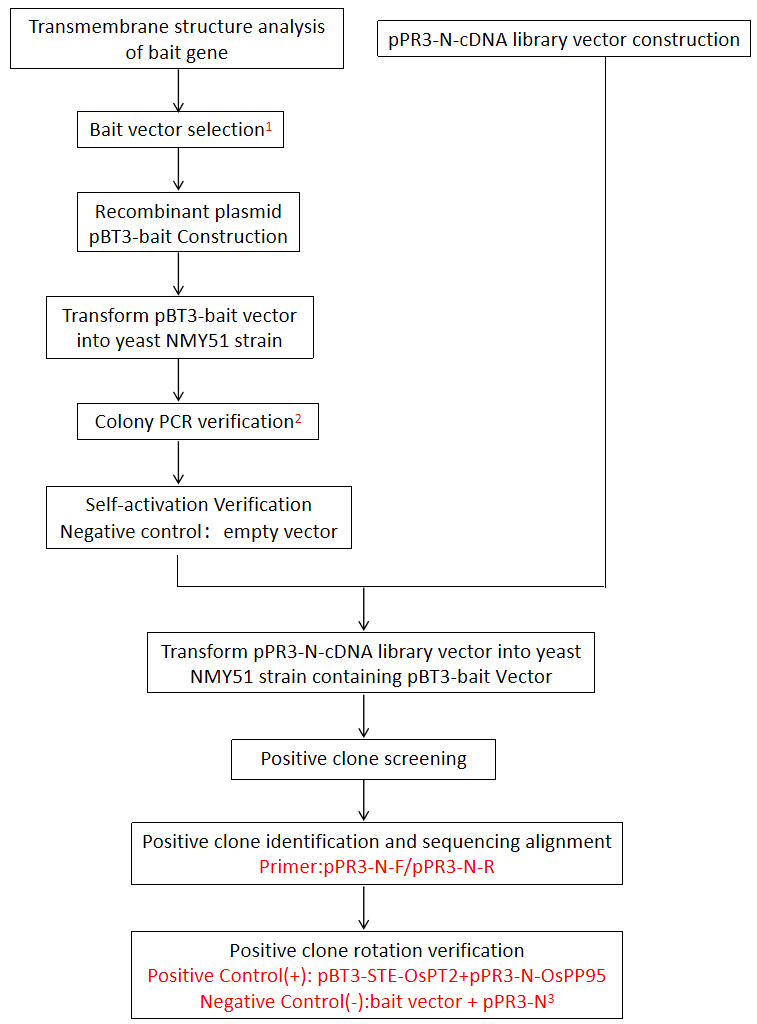Products
Innovative Yeast-Based And Molecular Biology Kits To Accelerate Your Life Sciences Research.
PRODUCTS



Yeast Two-Hybrid (Membrane System) Vector Kit

Price:
The Yeast Two-Hybrid (Membrane System) Vector Kit is designed for precise protein interaction analysis. Includes NMY51 yeast strain, bait and prey plasmids, and controls for membrane protein screening or one-to-one verification. Reliable, versatile, and ideal for advanced research.
INSTRUCTION & COA:
- Product Description
-
Product Overview
The Yeast Two-Hybrid (Membrane System) Vector Kit provides a comprehensive solution for membrane protein library screening and one-to-one verification of protein interactions. It includes the NMY51 yeast strain (MATa type), three Bait plasmids (pBT3-STE, pBT3-SUC, and pBT3-N), and the Prey plasmid pPR3-N. Positive control plasmid combinations (pBT3-STE-OsPT2 + pPR3-N-OsPP95) and a negative control (Bait plasmid + pPR3-N) are also included to ensure reliable results.
Product Code: RY8010
Price and Instruction: Available upon inquiry
Key Features
High versatility: Supports both membrane protein library screening and one-to-one interaction analysis.
Positive and negative controls included for validation.
Broad applicability across various membrane and cytoplasmic protein studies.
Product Components
Component
Name
Concentration
Specification
Quantity
Plasmids
pPR3-N
100ng/uL
20uL
1 tube
pBT3-STE
100ng/uL
20uL
1 tube
pBT3-SUC
100ng/uL
20uL
1 tube
pBT3-N
100ng/uL
20uL
1 tube
pNubG-Fe65
100ng/uL
20uL
1 tube
pTSU2-APP
100ng/uL
20uL
1 tube
Strain
NMY51
Inoculated Plate
Diameter:90mm
1 plate
Primers
pPR3-N-F
Lyophilized powder
2OD
1 tube
pPR3-N-R
Lyophilized powder
2OD
1 tube
pBT3-SUC/STE-F
Lyophilized powder
2OD
1 tube
pBT3-SUC/STE-R
Lyophilized powder
2OD
1 tube
pBT3-N-F
Lyophilized powder
2OD
1 tube
pBT3-N-R
Lyophilized powder
2OD
1 tube
Primer Sequence
Primer Name
Sequence
Applicable Vector
pPR3-N-F
CGGTAAAACCGGAACATTGGA
pPR3-N
pPR3-N-R
ACTTCAGGTTGTCTAACTCCT
pBT3-SUC/STE-F
TGGCATGCATGTGCTCTG
pBT3-SUC
pBT3-SUC/STE-R
GTAAGGTGGACTCCTTCT
pBT3-STE
pBT3-N-F
CAGAAGGAGTCCACCTTAC
pBT3-N
pBT3-N-R
AAGCGTGACATAACTAATTAC
Storage and Shipping Conditions
Plasmids: Store at -20°C; shipped at room temperature.
Strains: Store and ship at room temperature.
Primers: Store at -20°C; shipped at room temperature.
Experimental Guidelines

Selection of bait plasmid vectors:
Type
N-terminal
C-terminal
Bait Vector
Prey Vector
1
inside
outside
pBT3-N
pBT3-N
2
outside
inside
pBT3-STE
3
inside
inside
pBT3-N or pBT3-STE
4
No transmembrane structure
pBT3-SUC
Note: For proteins with signal peptides, remove the signal peptide before vector construction.
Self-prepared Materials
1. Sterile PCR tubes, tips, centrifuge tubes, shakers, incubators, and reagents like 50% PEG3350, 1M LiAc, X-α-Gal, and 3-AT.
2. (Optional from Pronetbio) Yeast media (YPDA, SD-Trp, SD-Trp/-Leu/-His), yeast plasmid extraction kits, and positive clone amplification kits.
Precautions
1. To ensure strain viability, streak the strain onto a YPDA agar plate before liquid culturing.
2. Store strains at -80°C with 50% glycerol to prevent repeated freeze-thaw cycles.
3. This product is for research use only and not for clinical, diagnostic, or therapeutic applications.
4. Maintain sterile conditions to avoid contamination.
FAQs
What is the difference between X-α-Gal and X-Gal?
X-Gal is the substrate for β-galactosidase, producing a blue product. X-α-Gal is the substrate for yeast α-galactosidase (MEL1) used for blue-white screening in yeast two-hybrid systems. They are not interchangeable.
Why use 3-AT to suppress self-activation?
3-AT is a competitive inhibitor of histidine synthesis, reducing HIS3 background expression and suppressing weak self-activation.
Why do yeast colonies turn red?
Red colonies result from adenine biosynthesis defects. Accumulation of intermediates like AIR causes red pigmentation. This is not contamination.
Why might screened proteins localize to various organelles?
Yeast two-hybrid detects direct interactions independent of protein localization. Positive interactions could involve proteins from membranes, nuclei, mitochondria, or other organelles.
Do membrane system screenings always yield membrane proteins?
No. Interacting proteins may localize differently, as the assay measures physical proximity and interaction rather than subcellular localization.
How to choose bait plasmid vectors?
Based on transmembrane orientation:
N-terminal
C-terminal
Vector
Inside
Outside
pBT3-N
Outside
Inside
pBT3-SUC
Inside
Inside
pBT3-N or pBT3-STE
No TM
-
pBT3-SUC
Ready to Advance Your Research?
Contact us today for a detailed consultation and product quotation. Let us help you unlock new insights in protein interaction research. When inquiring about this product, please reference Product Code: RY8010.
Related Service: Membrane Yeast Two-Hybrid (MYTH) Screening Service (Service Code: SRY8010)
Statement: All products are for research purposes only. Not for use in diagnostic or therapeutic applications.
Keywords: yeast two-hybrid membrane system, protein interaction analysis, MYTH vector kit, membrane protein screening, bait and prey plasmids, X-α-Gal, yeast strain NMY51, protein-protein interaction verification.

Contact Us

Tel: +86 025-85205672

Email: info@pronetbio.com

Address: Building 3C, Nanjing Xianlin Zhigu,
Qixia District, Nanjing, Jiangsu, China, 210033

Need more info?
Let's connect!


